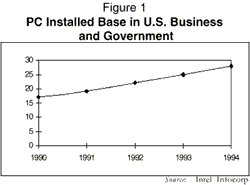
The thesis of this article is that if we are to establish an NII of any substance, it will be based on the interconnection of personal computers with on-line services and the Internet. PCs, not television, will be used by people to communicate with each other. Unfortunately, a widely-held belief that personal computers serve only a small, technically savvy, and wealthy elite--coupled with concern that computers are too difficult for mere mortals to use -- has mistakenly put the spotlight on creating interactivity on the television. This, compounded with the fact that TVs are present in virtually every home, resulted in some erroneous conclusions. In fact, television was designed for one thing only: moving pictures. It is a poor device for handling the high-resolution static images required for a high degree of interactivity. With the possible exception of video games (which serve a relatively small segment of the market), it is primarily a passive device. The fact that there are so many TVs is not relevant. If it were, we would have long ago considered "interactive radio." The number of televisions has become a false beacon for media companies, communications companies, equipment suppliers, and government policy makers.
Since the technological and social infrastructure for interactive television does not exist -- and its creation would be a truly awesome task -- government has stepped into the breach, preoccupying itself with fostering its existence, and getting involved in the processes by which it will evolve. Issues of interoperability standards, competitive markets, and universal access have become matters of public policy. This is further complicated by the fact that television and telecommunications services are regulated, implying the need for regulation of interactive television and, by implication, the information superhighway.
It is our contention that this approach of imposing the television as the interactive communication device standard is based on a set of mistaken assumptions. The fact is that the ubiquitous information device exists now in the form of the personal computer. In fact, while the government and the telecommunications companies argue about how best to deregulate the telecom industry, consumers are voting with their pocketbooks by purchasing personal computers, the only available interactive information device, at record levels. The role model for the diffusion of personal computers into society may well resemble the adoption of the automobile: It would have been difficult to imagine in the early days of the "model T" that 88% of American homes would have one or more automobiles. And, in the case of the personal computer, business to a large extent is underwriting both the investment in developing the networks (the role the government had to play in developing the highway system for the automobile) and, very importantly, the training of a large number of consumers in the use of computers. (Approximately 30% of the U.S. labor force and 47% of the white collar labor force use a computer at work and most children learn to use computers at school.)
Telephone and cable companies have been regulated for most of their existence. As a result, they are well positioned to influence government policy with respect to the information superhighway. The computer industry, on the other hand, has had almost no regulation and has had little to no involvement with government. Those of us in the computer industry need to do our part in demonstrating to our policy makers that the information superhighway is already under construction. It is being built primarily on PC technology by private industry, driven by competitive market forces, and with little, if any, need for government regulation.
There is a role for government, however -- to recognize and embrace the personal computer. This can provide America with a foundation for the next century that will not only improve the quality of our lives, but also improve the productivity of our society and the competitiveness of our industries. The government can do many things to move this along. It can facilitate access to computing in schools, libraries, and community centers. It can become one of the largest (maybe the largest) content provider of on-line information. It can encourage business to promote telecommuting. The most important thing the government can do is to recognize what is happening. However, we caution against interference with market forces. The market moved the personal computer industry forward at a phenomenal pace, and we encourage following this model rather than the heavily-regulated telecommunications model that has proven slow to evolve and respond.
THE HISTORY
While, today, the primary use of personal computers is in business, it is interesting to note that it was originally conceived as a consumer product. The first personal computers were designed for either hobbyists (the Altair) or for consumers (the Apple II). Even IBM broke with its tradition of providing business products (the "B" in IBM) when it introduced the PC in 1981. This machine, which is the ancestor of over 85% of the computers sold today, actually had a game port for joysticks and an audio cassette for storage. Industry leaders at the time, such as Ken Olsen, then CEO of Digital Equipment Corporation, openly referred to personal computers as "toys." Few realized that these toys would completely restructure the entire computer industry within 10 years.
The personal computer overtook the mainframe with its terminals as the information tool of business sometime during the 1980s. It is interesting to note that, although there are clear reasons for this success, the mainframe was not without its merits. As a centralized facility, a mainframe is easy to control. Each user has access to the same software, and support is easy. Another clear advantage of mainframes is that, since they are a shared commodity, it is easy to manage capacity to match the average expected load. On the other hand, under peak usage, all users typically experience slower performance. Probably, the main reason for the rapid decline of the mainframe, however, is the slow pace of progress in both hardware and software performance.
While there are many reasons for the success of the PC in business, the most important is its evolutionary nature. The "openness" of the PC allowed for rapid innovation. The open bus inspired hardware companies to add value to the basic PC. They experimented in the marketplace. Successful additions were then integrated into the main computer. It is hard to imagine that the first PC had a built-in game port, while the printer port was optional. Application software could be created by small companies. Companies like Lotus and WordPerfect grew from one product, while Microsoft took an early lead in the operating system and Novell provided the next work environment. While this environment was, and still is, chaotic, it provided for rapid evolution. No industry or government organization dictated the direction or set the standards, yet standard interfaces evolved out of economic necessity. The customers reward companies for innovation. When a company won in the market, others would accept its standard as the de facto standard and would seek to integrate their products into it. In the process, the personal computer became the tool of business. The adoption of personal computing into business in the United States was rapid (see Figure 1).

This was followed by the growth in computer networks as shown in Figure 2.
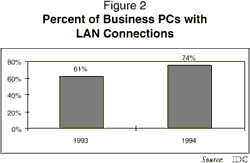
Electronic mail has followed word-processing and spreadsheets as a key business application. This has made the PC a fundamental communication device. While e-mail has historically been used within a company, more and more companies are using it as a way of communicating with the outside world (customers, vendors, and partners). Now, many individuals are finding that they can also send notes to friends and relatives. E-mail is only the first example of the successful marriage of personal computers and the NII: communication between people through the computer. At Intel, e-mail is a "mission critical" application; the corporation functions through the rapid transaction of issues and ideas using the worldwide electronic mail system.
The term "social computing" is gaining currency. A poor term no doubt, but a powerful concept. And while standards bodies were formed to address the methods by which different electronic mail systems would communicate (x.400 for instance), the Internet became the lingua franca of e-mail. Now, as businesses connect to the Internet to send and receive mail, they are also discovering that they can access a wide variety of information there as well. More and more companies are beginning to use the World Wide Web to communicate with the outside world. The growth of the Internet is staggering. It is estimated that, at the present moment, 10,000 companies are adding their presence to the Internet each week.
THE GROWTH OF THE HOME MARKET
The growth of computing in the home has been a surprise even to those in the industry. Figure 3 shows historical home penetration in the United States. It is expected that 10 million personal computers will be sold to consumers for use at home in 1995.
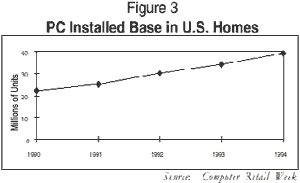
Although these numbers are impressive, they do not do justice to the number of consumers that use computers either at work or at school. While it may be true that the use of computers is not easy to learn (is the use of automobiles?), computers clearly satisfy a compelling need. For the first time, consumers spent more money on computers in 1994 than on TVs and VCRs combined, making the PC the most successful consumer electronic device. Another indication of the success of the personal computer in the home is that, of the over six million PCs sold to consumers in 1994, about 25% were additional computers to homes already owning one or more PCs.
In the early 1990s, a critical mass of home PCs equipped with modems enabled an explosion in a new industry: the on-line marketplace. Customers are now finding that much of the value of having a personal computer resides in the ability to connect with other users and with a large number of on-line services.
It should be noted that, although over 30% of U.S. homes are already equipped with PCs (a ramp faster than many consumer electronic products), the growth shows no sign of slowing down. On the contrary, with other countries joining in, worldwide shipments of PCs are expected to grow from 60 million units in 1995 to over 100 million by the year 2000.
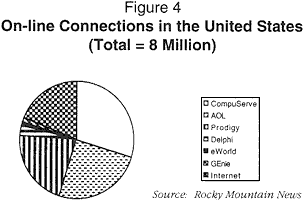
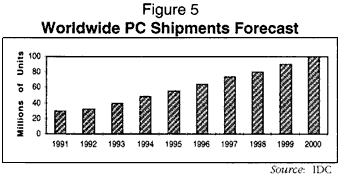
TODAY'S CAPACITIES
The power of today's computer is mind-boggling by the standards of just a decade ago. The typical computer being purchased has a powerful microprocessor (typically, a Pentium) with computing power equal to the mainframe of just six years ago. This, combined with a high-resolution display, a CD-ROM, and CD-quality audio sound provides for a rich multimedia experience. Today's PC uses compression to display video that matches the quality of a typical VCR with only 0.5% of the information required for an analog video stream. The decompression of the data is performed in the microprocessor without any specialized hardware. In addition to this, it can act as a fax machine and provide access to on-line networks and the Internet. It is used for a variety of purposes from entertainment to education, work-at-home, and home shopping.
TOMORROW'S CAPABILITIES
The capabilities of the personal computer are improving at a rate no other device has ever experienced. Historically, the power of a PC has doubled every 18 months. This rate has recently increased, and the capabilities are doubling every 12 months. What will we do with such computing power? Here are some of the most obvious areas:
THE STRUCTURE OF THE INDUSTRY
Historically, the computer industry was vertically integrated. Computer companies did everything from designing their own power supplies to developing application software. Each "vertical stack" was unique and proprietary. The PC changed all that. The PC industry is basically horizontal, with literally thousands of companies delivering compatible products, at every level of integration, and in many areas of applications.
The result of the horizontal nature of the computer industry is fierce competition at every level along both quality and price. This competition benefits customers who have access to the performance at the lowest prices. De facto interfaces have emerged at the intersection of the various segments. Periodically, ad hoc industry groups are formed to cooperate in creating new interfaces. An example is the PCI bus, which has become the standard for the high-speed internal bus of personal computers.
The cable television industry still operates in the traditional vertical organization. Cable companies are the only suppliers of both equipment and services, and most consumers don't even have the opportunity to buy their own equipment. As a result, equipment is typically not interoperable between different companies, technical progress is slow, and prices do not decline. This slow progress, in turn, stands in the way of improvements in other parts of the value delivery chain (such as the picture-in-picture feature which is disabled by most set-top boxes). As a result, government has recently stepped in to regulate both function and price.
PURPOSE
The television was designed to bring visual entertainment, from the movie theater and the stage, into the home. This emphasis on the visual is seen, for example, in the fact that, until recently, the quality of television speakers was far below that of other consumer electronics devices and that, even today, few programs are broadcast in stereo. To its credit (depending on your point of view), the television also enabled some new forms of entertainment such as game shows and brought us news footage. A common element to all these experiences is that they are typically enjoyed in the family room, from a comfortable distance, in a reclined position. The PC, on the other hand, was originally designed as a work tool and a platform for gaming. Two of the first applications to exist on the PC were the Lotus 123 spreadsheet and Microsoft's Flight Simulator. Although these applications would seem to be very different, they both required the user to sit close to the PC and to interact with it on a continuous basis (whether the device used is a keyboard or a joystick is not important).
FEATURES
The NTSC standard for television broadcast in the United States specifies 483 lines of video. In practice, most broadcasts and most VCRs are only capable of about half of that. By contrast, the minimum resolution for any personal computer monitor sold today is 1024 x 768, with many exceeding that. There are many reasons that explain the "poor" resolution of televisions the most significant being that it is adequate for the purpose at hand, and the cost of upgrading the system is huge. But resolution is only one of the differences. Probably much more crucial is the fact that the PC is inherently an "intelligent" device capable of processing information locally and of interacting directly with the user. The PC also has local storage that can be used for programs, data, video, or whatever the user thinks is important.
EVOLUTION
The single-most important difference between the TV and the PC has nothing to do with any one feature but with the fact that the PC is constantly changing, in effect adding features on a regular basis. For those who live in the world of telecommunications and television where things move very slowly (witness ISDN and HDTV), the PC hyper-growth may be difficult to comprehend. Now that HDTV is being proposed, the TV is being asked to do something it has not done in 40 years: evolve. Televisions have remained fundamentally the same, with the exception of screen size, since the introduction of color TV almost 40 years ago (even that change was a very painful one that resulted in a compromise that still hurts the picture quality of television). While some features have been added to the television, and the VCR gave it a limited linear memory, most new features are seldom used.
INTERACTIVITY
We define interactivity as an activity where individuals are fully engaged in a process. Interaction is something that involves an interplay between people or between people and devices such as a computer. We wish to contrast that to control and navigation. While there may be a brief moment or two where we interact with our remote control and TV in order to select a program of interest, success usually means long stretches of passive involvement with the program of choice. While the telephone can be used for some form of interactive information retrieval or even to perform a transaction by using the keys and following a menu of choices, most would agree that this is not a very enjoyable experience, and it is not suitable for sustained periods of time. This should be contrasted with the PC, a device with which individuals routinely interact for hours at a time.
CONNECTIVITY
The TV was built from the start to be a "communications" device -- albeit one-way communications. After all, a TV without a connection to the outside world is useless. In fact, it is the television network, especially cable, rather than the TV itself, that has expanded to offer more services. So it is this paradigm that has motivated the communications companies to approach the problem of providing interactive service to American consumers in a similar way. It is therefore very ironic that the PC, which gave users the independence to work on their own and to break away from the mainframe, is, in fact, the superior communications device. This is because, on the PC, which is capable of producing, processing, and storing information, communications evolved from the very start as a two-way interaction.
The TV is only easy to use if it is used in its simplest form. To make the TV more intelligent in order to be interactive, something has to be added to it. This is typically called an intelligent set-top box. The idea is to add to the TV many of the functions of the personal computer and the game machine -- but at a price that is consistent with television pricing (typically, $300 is the target). Since $300 does not buy a lot of computing power, much of the intelligence needs to be somewhere else in the network where it can presumably be shared. If this sounds familiar, it is because it copies the mainframe/dumb terminal concept. The computer industry has the advantage of having seen that movie and of being familiar with its pitfalls. Since the intelligent PC was so successful in replacing the mainframe 10 years ago, there is no need, this time, to go through the same steps.
A WORD ABOUT THE TELEPHONE INDUSTRY
Much of what was said about the television is also true of the telephone. This device, too, has been slow to evolve (touch-tone being the last, and probably first, breakthrough in the device itself). Here, too, it is the network which is responsible for most innovations such as 800 service and call waiting. The awaited breakthrough on the telephone side (equivalent to HDTV) has been some form of video telephony. All attempts have failed because the cost and quality have not been there. On the other hand, personal computers have offered video telephony. incorporating application sharing, on ISDN for some time. It is expected that the personal computer's current trajectory will allow it to offer a marketable quality video telephony product over POTS within the current year with the simple addition of a camera.
As the television and telephone industries eye each other's heartland but consider the massive cost of doing battle with each other, they each hope to create an advantage by offering a new class of service: interactive TV services. Unfortunately, they both have a poor track record in evolving their businesses. And this time, they must build their new infrastructures in a matter of years -- not decades.
This "economic barrier" should not be construed as an opportunity for the television to evolve into interactive television. We believe that the cost of interactive TV (both the device itself and the network) would limit its availability to pockets of high income families. Since the PC is a multifunction device, its cost is, in fact, less of an obstacle -- as can be seen by its fast ramp so far.
The following key characteristics of the personal computer industry ensure that the PC will continue to be the primary interactive device of the information superhighway:
REQUIREMENTS FOR NII
The first requirement is an access point with an interactive device. By this, we refer to interactivity as defined by the current and evolving personal computers, as opposed to improvements in the navigation and control capabilities of TV. We assume that PCs will not only become easier to use, but will be able to handle "rich" media (video, audio, and images, in addition to text), with better and better quality.
Next, we need a communications infrastructure that connects these access points to services and to each other. This connection must provide adequate bandwidth in order to enable the use of rich, multimedia data types. The current POTS environment, even with the latest 28.8 Kb/s data rate, is extremely limiting. ISDN is a short- and intermediate-term opportunity to increase bandwidth to the consumer. Over time, broadband capabilities will be needed. It should be noted that bandwidth symmetry is not required as long as "adequate" bandwidth is available in the return path. For example, the current PC-to-cable connection experiments, while highly asymmetric in bandwidth, would be quite adequate for accessing existing Internet sources. Clearly, we will need higher bandwidth in the return path if we are to expand beyond current modes of use and allow every user to become a contributor of rich data.
In an important departure from the current circuit-switched networks that connect most businesses and individuals, the network for the NII needs to be packet switched. This requirement is born out of the desire for an "always on" mode of operation and for the ability to have multiple sessions active at the same time. The Internet is packet switched, but much of the potential is lost in the circuit-switched POTS network that connects homes to the Internet over the "last mile."
If we are to broadly utilize the NII for applications such as electronic commerce, security considerations are going to become important. However, we consider this to be an issue between the two end points of the transactions and not of the network. Current industry efforts, we believe, will solve this problem quite adequately.
WHAT CAN/SHOULD THE GOVERNMENT DO AND NOT DO?
The government should: